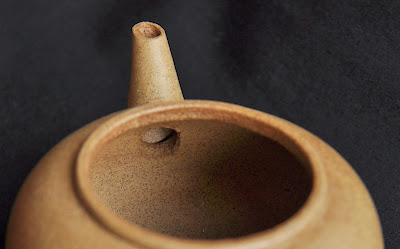We start with these pieces from the Yingge Wares branding project. The museum in this ceramic town helps the local potters by promoting their wares in the museum.
This kind of marketing may not seem part of the purpose of a museum. However, I think it's important that a ceramic museum in a ceramic town not just display objects from the past, but helps to connect the past and the present.
The museum also organizes competitions from time to time.
And exhibitions are not just focused on Yingge potters, but have an international reach (as I reported in the past about a fellow blogger from Switzerland).
The following pots are very creative, but I doubt they work well as teapots:
A video in the exhibition shows how to handle each pot.
If you have hot water, it may even be possible to iron some cloths with this next pot!
The shape I liked best is the celadon teapot with handle inspired by a Tang dynasty Changsha ever. This is a nice way to connect the past with the present: a classic shape that finds a new life with some adjustments (a longer handle and a different glaze).
We finish the tour of the museum with 2 curious teapots that look like wood:
Amazing imitations!
Now, I would like to present some modern Yixing teapots that I have for sale for (a little) less than 100 USD (each)! Their shapes are simple and classic.
We start with this black zisha Yixing: (Update: Sold)
Weight: 153 gr
Volume: 19-20 cl (190-200 ml)
I havd heard several different stories about how this black color is obtained, so I was curious to try one.
Due to a medium firing, it's rather porous and suitable for roasted Oolongs or puerh.
A duanni Shuiping teapot: (Update: Sold)
Volume: 11 cl (110 ml)
Single hole.
The clay seems mixed with some zisha clay to create a darker color. The result looks quite natural.
The firing temperature was rather high.
A hungni 'oil lamp' shape teapot:
Weight: 116 gr
Volume: 13.5 cl (135 ml)
Flat filter with 7 holes
Early 2000s. Gas fired at a high temperature.
This hungni clay is quite porous and also better suited for roasted Oolongs or puerh.
A zisha 'ju lun zhu' teapot: (Update: Sold)
Weight: 114 gr
Volume 14.5 cl (145 ml)
Medium fire
The big, flat, circular knob gives its name to this teapot. It's a design that's especially popular in Japan.
The clay is very soft. It was quite dirty when I received it and I spent a lot of effort cleaning it.
A small zisha Shuiping teapot: (Update: sold)
Weight: 67.5 gr
Volume: 8.5 cl (85 ml)
Single hole
End of 1990s teapot.
The walls of the cover are rather short. This small teapot is for one or two persons only.
This last teapot is a hungni Xishi. (Update: sold)
Weight: 83.5gr
Volume: 8.5 cl (85 ml)
High fired teapot
Single hole.
Tight: pressing on top of the knob makes the flow of water stop.
This hungni clay isn't very porous. It's suitable for more fragrant, unroasted Oolong or raw puerh.
First come, first serve! (I will update the article to indicate the teapots that are sold).
















































4 comments:
That small zisha Shuiping teapot is really sweet! What would you suggest we brew in it?
Hello Leaf,
This small zisha Shuiping is the typical all-round teapot. The shape isn't round, nor flat. The zisha clay isn't very hard or very porous. Therefore, it's quite an adaptable teapot, but not one with a perfect fit for one particular tea. The best is to try and let the teapot choose! (My educated guess is that it would like young raw puerhs the best).
Bonjour Stéphane !
Cela fait bien longtemps ... je bouge, je bouge et ne trouve que très peu de temps pour me poser et apprécier toutes les saveurs de tes posts en ce moment ...
Mais, en parcourant rapidement ton dernier article, aujourd'hui, mon regard se pose sur la zisha "ju lun zhu". Quels seraient les thés appropriés pour elle ?
Merci de ton attention !
Bonjour Hélène,
Merci de ta lecture.
Cette théière est vendue. Ronde, elle convient plus aux Oolongs roulés torréfiés.
Post a Comment